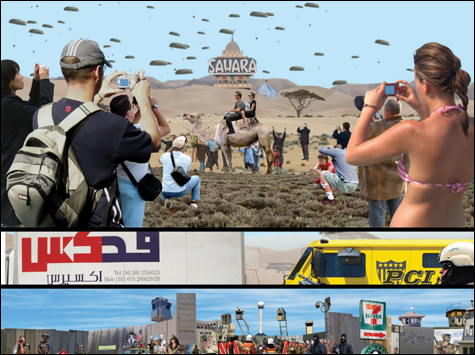
EMPYREAN One of the rare Internet-inspired pieces with rich, complex, coherent form. |
Brooklyn artist Cliff Evans’s video installation Empyrean, up now at the Isabella Stewart Gardner Museum, is a Web-induced digital fever dream of celebrities, war, sex, and religion straight out of Hieronymus Bosch’s late-15th- and early-16th-century paintings of temptation and Hell. When you watch it, the end feels very near.“Empyrean comes from all fire, total fire. It’s Greek,” the 30-year-old Boston Museum School grad tells me. “In Western culture, in Christian culture, it’s probably most famously used in Dante’s cycle. But it doesn’t mean Hell. In his sense, it’s pure light, it’s the firmament, it’s where God resides. It’s something you can’t see because it’s so pure.” For Evans, it evokes the overwhelming everything multitude of the Web, the white-out of overexposure, and thoughts of American empire-building militarism.
The project, organized here by Gardner contemporary-art curator Pieranna Cavalchini, grew out of his residency at the museum last year. He uses five projectors to create an animated altarpiece, turning the darkened gallery into a chapel. It feels suffused with the religious tone of much of the museum’s art and architecture. But it also springs from his Catholic childhood in East Texas.
Hollywood desert-epic music (from Lawrence of Arabia) plays as the videos begin. Brad Pitt and Angelina Jolie ride a crudely animated camel across sand dunes, with the marquis for the Sahara casino in Las Vegas standing in the distance. Pitt holds a skull. Jolie holds a blue United Nations flag. In the distance, paratroopers float down from the sky.
A dense web of associations is conjured. The Sahara was the setting of the 1960 flick Ocean’s 11, in which a heist is planned by a group of former paratroopers. It was remade in 2001 starring Pitt. His girlfriend Jolie has worked as a UN good-will ambassador since 2001 and is often mocked for adopting children from Cambodia and Ethiopia. The soldiers and the desert suggest Iraq. Put it all together and it speaks of America’s delicate and awkward dance of reaching out to help other countries, shallow posturing, and colonialism.
With a buzzing wail, the scene shifts to a military drone plane, a soldier in a surgical mask holding some monstrous one-legged body, and bloody dirty people who appear to be victims of a terrorist bombing. A man’s ear falls off. People don gas masks.
It’s impossible to take in all in at once. Evans digitally assembled the six densely collaged simultaneous scenes from images he found on the Web. The videos are mostly flat planes of imagery drifting across one another, and some limited animation. The scenes seep into your brain. The images feel familiar, but if you try to place them, they’re elusive. What is real and what is fiction becomes slippery, a reflection of our synthetic double-speak era. “If someone has violence done to them in the pieces, those are initially from simulations,” says Evans. “They’re from hazmat exercises or military drills.”
Adam and Eve mannequins and dinosaurs wander under an arch of orange trees. A human-ape hybrid couple wander a desert landscape, beyond an arch of skulls. American troops patrol. Then a monster — perhaps the Beast from the Book of Revelation — flaps into the center panel. It has a leopard head, naked woman’s breasts, and skulls.
Lots of artists have been mining the Internet for material. Often the result is an aimless jumble that simply reflects the Web’s chaos back at us. But Empyrean is one of the rare Internet-inspired pieces with rich, complex, coherent form. Each time I watched it, I found new images, new layers, new connections. All this Apocalyptic stuff feels somewhat easy and reductive, however. Apocalyptic fervor has been one of humanity’s favorite pastimes for ages. What makes our version special? But dreaming of the Apocalypse is always fun. Here it’s a thrilling, seductive, action-packed romp.
The video’s final section opens on a bomb-blasted car. The wreck is flanked by rubble and giant concrete walls resembling the barrier erected in recent years between Israel and the Palestinian territories. Apache helicopters hover. A tank rumbles past followed by a guy driving an ox cart. A man in the orange garb of Guantánamo prisoners waves. Another man holds up his purple-stained finger, indicating he voted in Iraqi elections. After six minutes, the videos end with a white-out and timpani and a feeling of relief. And then they begin again.